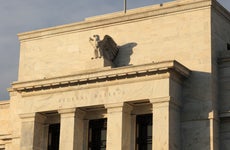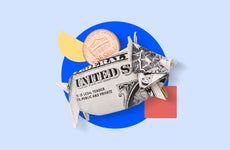Top high-yield savings accounts are now beating inflation. Here’s why that’s important

The Bankrate promise
At Bankrate we strive to help you make smarter financial decisions. While we adhere to strict , this post may contain references to products from our partners. Here's an explanation for .
Key takeaways
- Top savings rates have been outpacing inflation, making it a good time to have your money in a high-yield savings account.
- You can find savings accounts with APYs above 5 percent, while the rate of inflation is currently 3.3 percent.
- Having your funds in a high-yielding savings account helps maximize your money at a time when prices remain elevated on various goods and services.
Personal finance fact: Your money loses purchasing power over time, especially if it’s in a savings account that isn’t earning interest.
But there’s good news for savers: Since March 2023, the top savings yield has been outpacing inflation, according to Bankrate data.
The current savings rate environment features many top savings account annual percentage yields (APYs) actually outpacing 3.3 percent inflation. That wasn’t the case more than a year ago, when inflation was more than two times higher than it is now.
Inflation peaked at 9.1 percent in the summer of 2022. And you likely weren’t going to earn 9 percent on cash back then in a savings account from a bank insured by the Federal Deposit Insurance Corp. (FDIC).
“But over time, you want your cash earnings to be in the same zip code as inflation, just so you’re preserving your buying power,” says Greg McBride, CFA, Bankrate chief financial analyst.
How does inflation affect savings?
Money that doesn’t keep up with inflation is losing purchasing power.
Say you spent $20 at a restaurant in February 2019. Revisit the restaurant in February 2024, and you’d likely need $24.55 to buy the same items you purchased more than three years ago. So you’d either have to consider not getting an appetizer, a drink or get a less expensive meal. Or you’d have to scrounge an extra $4.55 to pay for the bill.
That’s how inflation affects your savings. Having that money in a high-yield savings account paying a competitive yield would keep up with inflation better than the money that would merely sit in your home not working for you.
Reasons why keeping up with inflation matters
Earning an APY that’s not only keeping up with inflation, but that’s surpassing it, helps maximize your savings at a time when prices are elevated on various goods and services. This, ultimately, gives you the ability to afford more of the things you want and need.
Here are seven reasons why keeping up with inflation matters.
1. A dollar today won’t buy as much as it will in the future.
Prices generally increase over time.
Money that isn’t keeping pace with inflation loses purchasing power over time. So, $20 left in your old winter coat in January 2019 could have bought $20 of goods back then. But now you’d need an extra $4.66 to make up the difference in rising costs and have the same buying power.
That $20 at 4.06 percent APY would have earned $4.40 in interest during the same five-year period, but it would have been difficult to find that type of yield on an FDIC-insured CD five years ago. A 5-year CD at 3.40 percent APY would have been the closest option at that time, according to Bankrate data. But 3.40 percent APY, or anything, is better than zero.
“If I have my money earning money at some percentage — even if it’s not exactly the same as inflation — and if I’m maximizing my savings, I get closer to meeting my inflation needs when inflationary periods hit,” says Jill Schlesinger, certified financial planner and business analyst for CBS News.
2. The highest savings yield doesn’t usually top inflation.
Most of the time, inflation outpaces the absolute top savings yield.
This is a comparison of the absolute top savings yields from July 2015 through March 2024 compared with inflation, using the Consumer Price Index for all urban consumers.
Higher yields may be available outside federally insured accounts. But if they aren’t federally insured, then you’re taking a risk. At some banks, higher yields might also be capped and only available on certain balances.
“When inflation is 9 percent, all cash underperforms inflation,” McBride says. “But over a longer period of time, if you’re seeking out the top-yielding account, you’re giving yourself the best chance to keep up with inflation,” he adds.
People should plan on an average inflation rate of at least 3 percent over the long term, McBride says.
3. But you still want the highest APY possible.
The highest yield should be your focus, as long as it’s at a bank insured by the FDIC. However, you want to look for consistency of APY because rates are generally variable.
You also want to make sure the account has a minimum opening deposit amount you’re comfortable with and that it doesn’t have any fees that are going to eat away at your competitive yield.
4. The average savings yield hasn’t topped inflation in over eight years.
Since October 2015, a savings account at the national average rate hasn’t outpaced inflation during a month. And some of the big banks are currently paying even less than the national average rate. In May 2020, inflation and the national average were the same.
Those who are earning savings interest at or below the national average rate have an opportunity to better keep up with inflation by putting money in a savings account at an online FDIC-insured bank that’s paying a competitive yield.
Also, don’t forget about money that’s sitting in a non-interest checking account that should really be put in a savings account if it’s not needed for many months. A Bankrate survey published in March found that 17 percent of people weren’t earning any interest, and 11 percent were unsure how much interest they were earning.
5. You need to factor inflation into retirement planning.
No matter whether you’re many years from retirement or are already retired, you need to keep up with inflation during retirement because you’ll likely be earning less. And your top earning years are likely behind you.
“If you’re planning for retirement, and you are planning to say, ‘OK, I can live on $5,000 today,’ Well if $5,000 today is … not the same amount of money as $5,000 ten years from now, you’ll need more money,” Schlesinger says. “So your money that you have has to grow faster than the rate of inflation to simply meet the needs that you have.”
Inflation will definitely affect people in their 20s, with retirement around 40 years away.
Inflation will affect someone retiring in around five or ten years both before and during retirement.
- $10,000 in May 2019 has the same buying power as $12,264 in May 2024.
- $10,000 in May 2014 has the same buying power as $13,202 in May2024.
Here’s a look at how inflation impacts money today versus 20 and 30 years ago:
- $10,000 in May 2004 has the same buying power as $16,609 in May 2024.
- $10,000 in May 1994 has the same buying power as $21,293 in May 2024.
Source of calculations: CPI Inflation Calculator, Bureau of Labor Statistics
6. Inflation isn’t likely to go away.
Even low inflation is still costing you purchasing power if you’re not keeping up with it.
“Essentially, a growing economy will have inflation,” Schlesinger says. “What we’re seeking is a way to understand how the impact of higher prices can sort of worm its way into your life in so many different ways. So the reason why the Fed really wants to control inflation is that inflation is quite pernicious. It impacts every single person.”
7. High inflation and market losses were a double whammy in 2022.
The S&P 500 was down 18.1 percent last year. And inflation peaked at 9.1 percent last June.
“If you haven’t been earning enough on your money, you can have a double whammy,” Schlesinger says. “The year 2022 is probably the worst year to think about in these terms because, on one hand, you had inflation (increasing) and, on the other hand, you had financial markets collapsing.”
Open an online savings account with a competitive yield in minutes
Online banks are where you’ll typically find savings accounts with the highest APYs. Opening an account online is typically a quick and straightforward process. You’ll be asked for information such as your name, Social Security number, date of birth and street address.
You can fund the new savings account by transferring the money from an existing bank account. Often, you can digitally deposit a check by uploading a picture of it.
These days, some high-yielding savings accounts are earning more than 20 times the rate offered by many big brick-and-mortar banks. For perspective, depositing $10,000 in a high-yield savings account that earns 5.25 percent APY would earn around $538 more in interest after a year than one in an account that earns merely 0.01 percent APY.
Bottom line
Your money loses purchasing power when the yield it’s earning doesn’t outpace the rate of inflation. It’s easy to feel good about the money you’ve saved, but the money you have right now won’t be able to buy as much in the future. Keeping up with inflation is a marathon, not a sprint. You can make sure you’re keeping up with it by having your savings in a competitive yielding account, and these are usually found at online, FDIC-insured banks.
— Bankrate senior writer Karen Bennett contributed to updating this article.
Related Articles



The best places to save your money: Money market accounts, savings accounts and CDs
